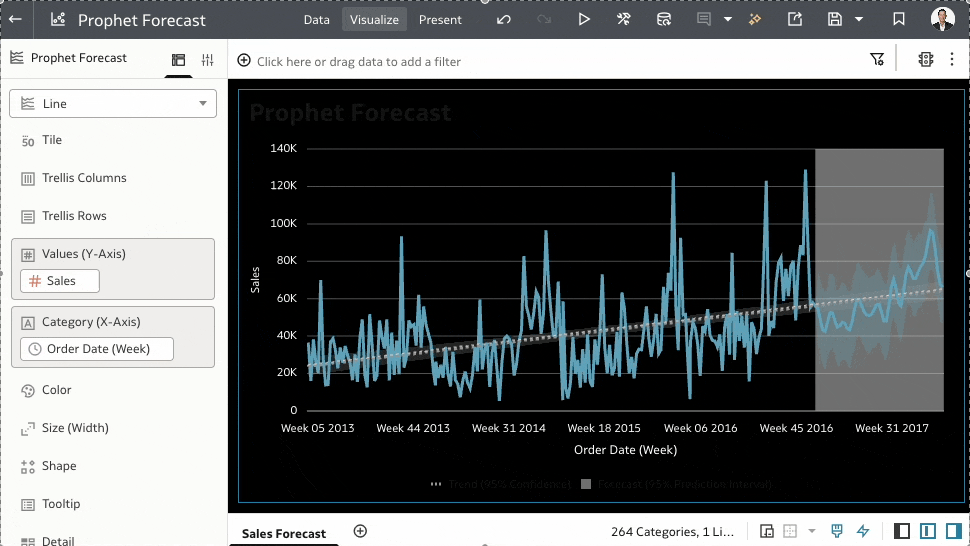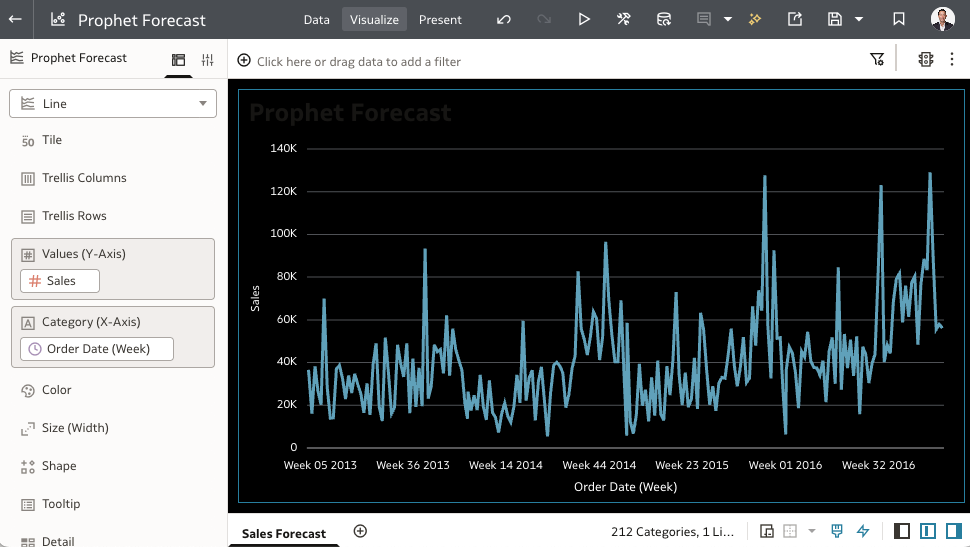
Overview
Forecasting is a core capability in Oracle Analytics helping business teams anticipate demand, revenue, inventory, and staffing needs with confidence.
Oracle is expanding the native forecasting toolbox with Prophet, the open-source time-series algorithm originally from Meta, now available directly in Oracle Analytics.
Prophet complements our existing algorithms:
- ARIMA
- Seasonal ARIMA
- ETS
Oracle Analytics is offering a 1-click feature to add a forecast.It’s business-friendly, highly automated, and provide a robust approach for data with multiple seasonality patterns.

Forecasting algorithms in Oracle Analytics
Oracle Analytics provides multiple algorithms so you can choose the best fit for your data and business context:
ARIMA (AutoRegressive Integrated Moving Average)
Strengths: Solid baseline for non-seasonal series; handles autocorrelation well.
Consider when: Data is relatively stable, stationary (or made stationary), and you need a parsimonious model.
Seasonal ARIMA (SARIMA)
Strengths: Extends ARIMA to capture explicit seasonality (e.g., weekly, monthly).
Consider when: You have strong, regular seasonal cycles and enough history to estimate seasonal parameters.
ETS (Error-Trend-Seasonality)
Strengths: Excellent for level/trend/seasonal patterns with smooth evolution; fast and interpretable.
Consider when: You need reliable, lightweight forecasting with limited tuning.
Prophet (new)
Strengths: Designed for business time series with automatic handling of trend changepoints, holidays, missing values, and multiple seasonalities.
Consider when: You have strong seasonality, irregular events, or structural breaks, or when you want robust performance with minimal manual tuning.
Benefits of Forecasting with Prophet
Prophet prioritizes practical accuracy with minimal tuning. It often delivers strong results faster than hand-tuned ARIMA/SARIMA, especially when the data isn’t perfectly stationary.
It natively offers support for multiple seasonal cycles and event effects helps capture real-world business rhythms without heavy feature engineering.
Finally, Prophet handles missing values, outliers, and trend shifts via changepoint detection, reducing the risk of brittle models.
How to use Prophet in Oracle Analytics in 3 steps
1. Start with a time-series visualization:
Create a line chart with a Date column on the X-axis and a continuous measure (Sales) on the Y-axis.

2. Open Properties and Analytics
From the visualization options, click on the Properties menu, then Analytics tab, and Add Statistics by clicking on the button. Select “Prophet” algorithm.

3. Configure your forecast
Set the method, to forecast the next periods as an example. State the number of periods. In my example, I’m forecasting the next 52 weeks. A common rule of thumb is to forecast up to one-third of your historical span. Select your model: Prophet. Confidence interval: Choose the interval (e.g., 95%) to display uncertainty bands.
Call to Action
By adding Prophet to Oracle Analytics alongside ARIMA, Seasonal ARIMA, and ETS, Oracle is giving business and analytics teams a practical, interpretable, and resilient way to forecast what matters so they can plan with confidence and act faster. Start using Prophet today and connect with the Product Managers in the Oracle Analytics Community to discuss your use case!
For more information:
